Case Study: Social Media Impact on Consumer Buying Behavior at TESCO
VerifiedAdded on 2023/06/11
|10
|2642
|88
Report
AI Summary
This report investigates the impact of social media on consumer buying behavior, focusing on a case study of Tesco in the UK. It outlines the research objectives, including understanding social media's role and its influence on Tesco's customers. The report also addresses strategic business issues related to social media marketing, literature review of the role of marketing in social media, how consumer use social media for buying decisions, social media strategy to influence consumer buying behavior. It details the proposed empirical investigation, research philosophy (interpretivism), approach (inductive), strategy (surveys and literature review), design (qualitative and quantitative), data collection methods (primary and secondary), sampling procedure (probability sampling), data analysis techniques (statistical data using MS Excel), and a project timeline. The research aims to provide recommendations for effective social media strategies for Tesco.
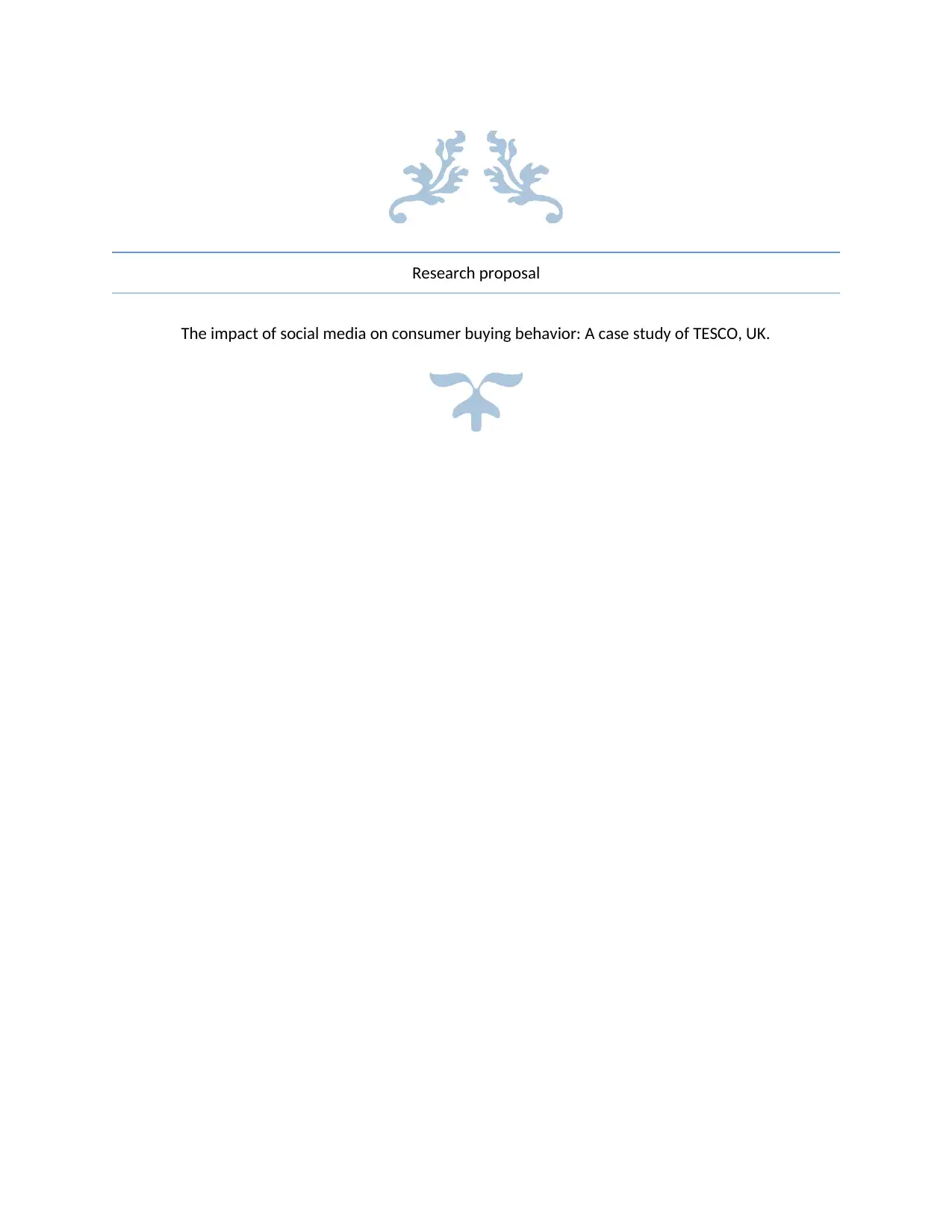
Research proposal
The impact of social media on consumer buying behavior: A case study of TESCO, UK.
The impact of social media on consumer buying behavior: A case study of TESCO, UK.
Paraphrase This Document
Need a fresh take? Get an instant paraphrase of this document with our AI Paraphraser
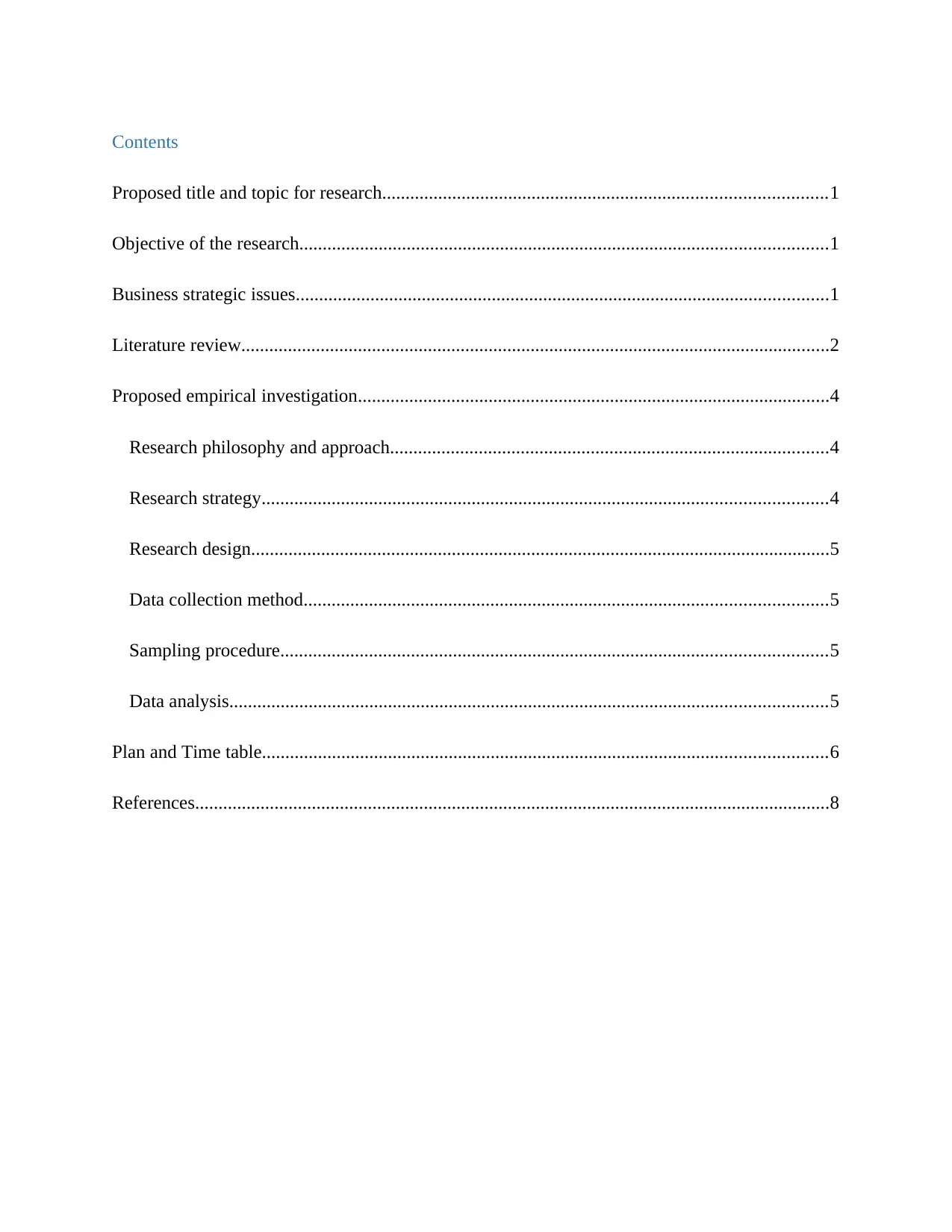
Contents
Proposed title and topic for research...............................................................................................1
Objective of the research.................................................................................................................1
Business strategic issues..................................................................................................................1
Literature review..............................................................................................................................2
Proposed empirical investigation.....................................................................................................4
Research philosophy and approach..............................................................................................4
Research strategy.........................................................................................................................4
Research design............................................................................................................................5
Data collection method................................................................................................................5
Sampling procedure.....................................................................................................................5
Data analysis................................................................................................................................5
Plan and Time table.........................................................................................................................6
References........................................................................................................................................8
Proposed title and topic for research...............................................................................................1
Objective of the research.................................................................................................................1
Business strategic issues..................................................................................................................1
Literature review..............................................................................................................................2
Proposed empirical investigation.....................................................................................................4
Research philosophy and approach..............................................................................................4
Research strategy.........................................................................................................................4
Research design............................................................................................................................5
Data collection method................................................................................................................5
Sampling procedure.....................................................................................................................5
Data analysis................................................................................................................................5
Plan and Time table.........................................................................................................................6
References........................................................................................................................................8
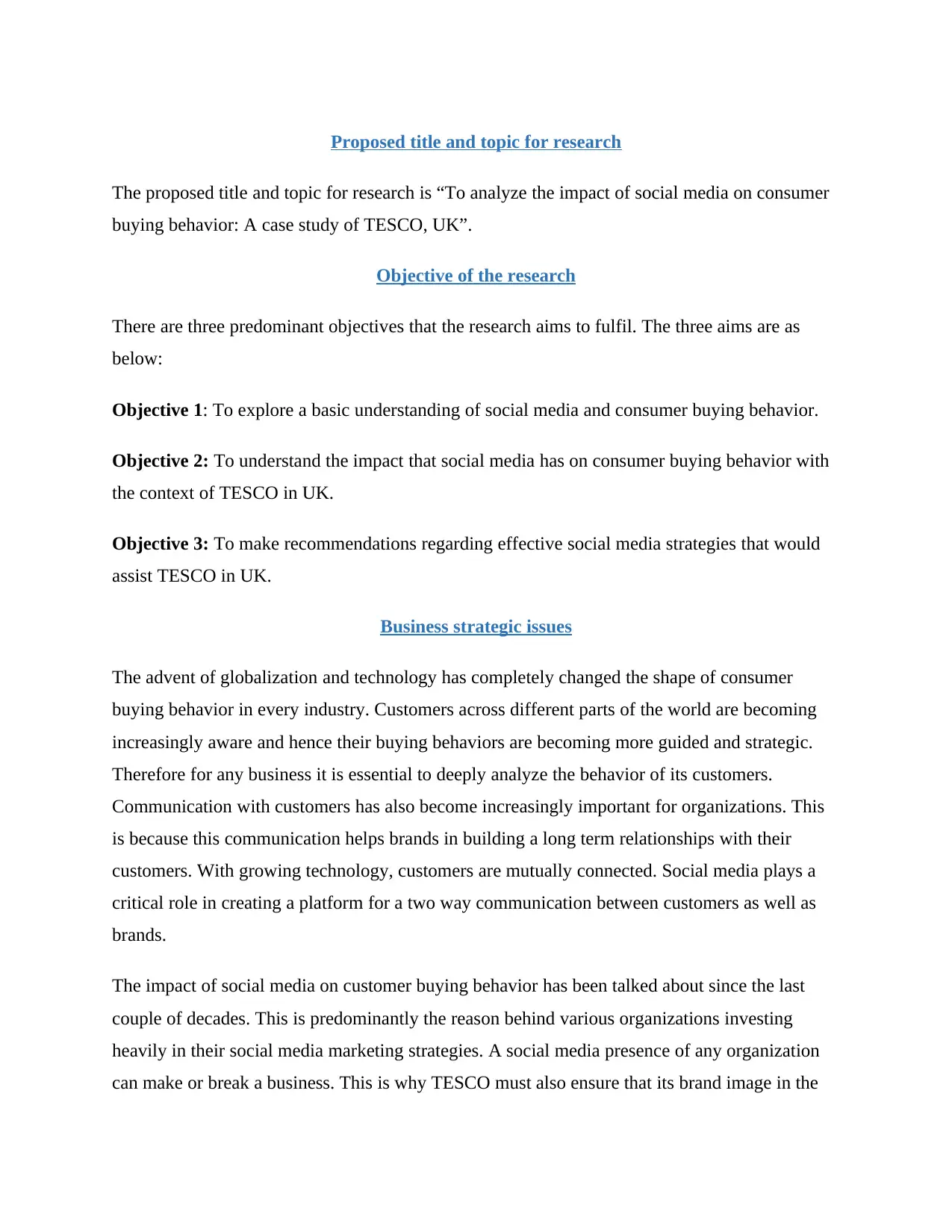
Proposed title and topic for research
The proposed title and topic for research is “To analyze the impact of social media on consumer
buying behavior: A case study of TESCO, UK”.
Objective of the research
There are three predominant objectives that the research aims to fulfil. The three aims are as
below:
Objective 1: To explore a basic understanding of social media and consumer buying behavior.
Objective 2: To understand the impact that social media has on consumer buying behavior with
the context of TESCO in UK.
Objective 3: To make recommendations regarding effective social media strategies that would
assist TESCO in UK.
Business strategic issues
The advent of globalization and technology has completely changed the shape of consumer
buying behavior in every industry. Customers across different parts of the world are becoming
increasingly aware and hence their buying behaviors are becoming more guided and strategic.
Therefore for any business it is essential to deeply analyze the behavior of its customers.
Communication with customers has also become increasingly important for organizations. This
is because this communication helps brands in building a long term relationships with their
customers. With growing technology, customers are mutually connected. Social media plays a
critical role in creating a platform for a two way communication between customers as well as
brands.
The impact of social media on customer buying behavior has been talked about since the last
couple of decades. This is predominantly the reason behind various organizations investing
heavily in their social media marketing strategies. A social media presence of any organization
can make or break a business. This is why TESCO must also ensure that its brand image in the
The proposed title and topic for research is “To analyze the impact of social media on consumer
buying behavior: A case study of TESCO, UK”.
Objective of the research
There are three predominant objectives that the research aims to fulfil. The three aims are as
below:
Objective 1: To explore a basic understanding of social media and consumer buying behavior.
Objective 2: To understand the impact that social media has on consumer buying behavior with
the context of TESCO in UK.
Objective 3: To make recommendations regarding effective social media strategies that would
assist TESCO in UK.
Business strategic issues
The advent of globalization and technology has completely changed the shape of consumer
buying behavior in every industry. Customers across different parts of the world are becoming
increasingly aware and hence their buying behaviors are becoming more guided and strategic.
Therefore for any business it is essential to deeply analyze the behavior of its customers.
Communication with customers has also become increasingly important for organizations. This
is because this communication helps brands in building a long term relationships with their
customers. With growing technology, customers are mutually connected. Social media plays a
critical role in creating a platform for a two way communication between customers as well as
brands.
The impact of social media on customer buying behavior has been talked about since the last
couple of decades. This is predominantly the reason behind various organizations investing
heavily in their social media marketing strategies. A social media presence of any organization
can make or break a business. This is why TESCO must also ensure that its brand image in the
⊘ This is a preview!⊘
Do you want full access?
Subscribe today to unlock all pages.

Trusted by 1+ million students worldwide
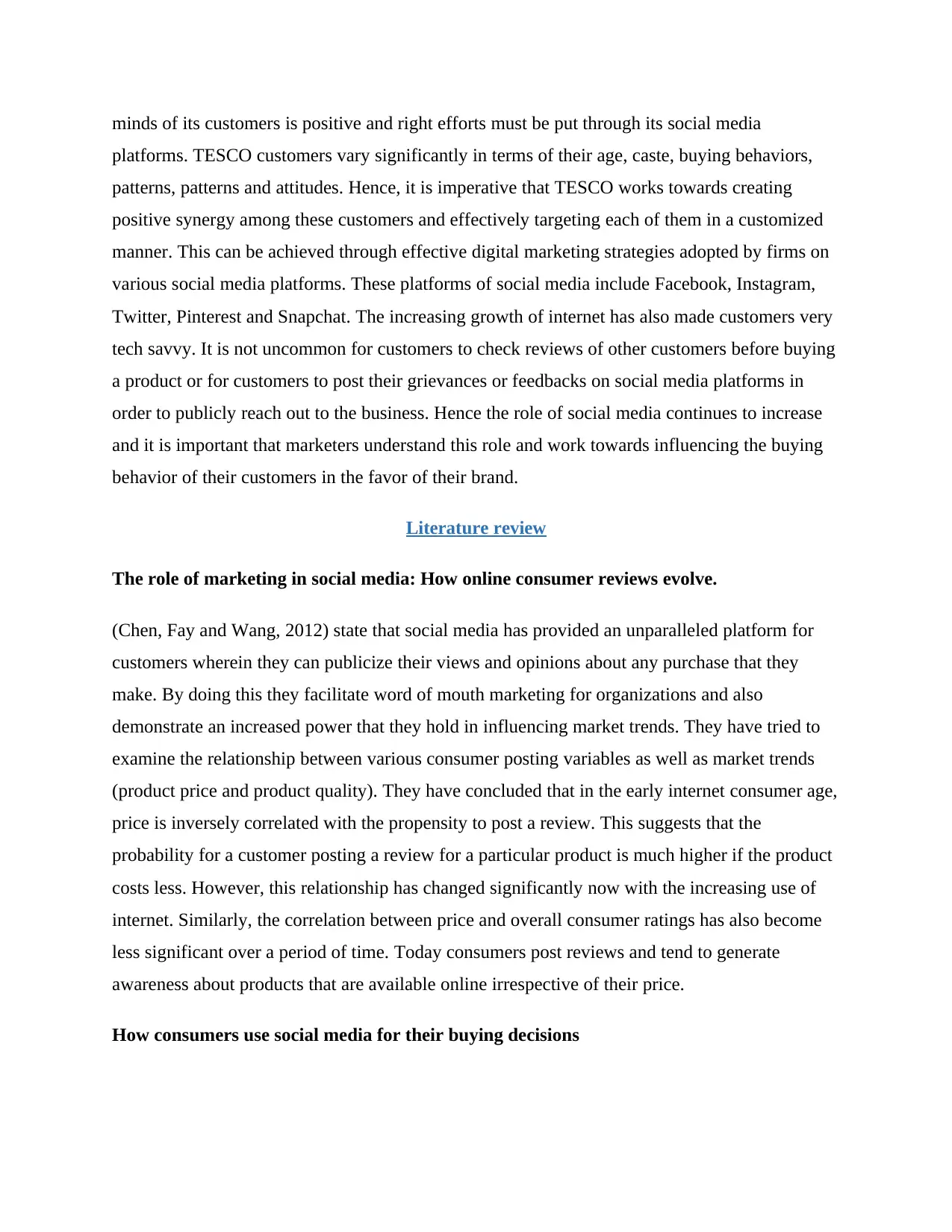
minds of its customers is positive and right efforts must be put through its social media
platforms. TESCO customers vary significantly in terms of their age, caste, buying behaviors,
patterns, patterns and attitudes. Hence, it is imperative that TESCO works towards creating
positive synergy among these customers and effectively targeting each of them in a customized
manner. This can be achieved through effective digital marketing strategies adopted by firms on
various social media platforms. These platforms of social media include Facebook, Instagram,
Twitter, Pinterest and Snapchat. The increasing growth of internet has also made customers very
tech savvy. It is not uncommon for customers to check reviews of other customers before buying
a product or for customers to post their grievances or feedbacks on social media platforms in
order to publicly reach out to the business. Hence the role of social media continues to increase
and it is important that marketers understand this role and work towards influencing the buying
behavior of their customers in the favor of their brand.
Literature review
The role of marketing in social media: How online consumer reviews evolve.
(Chen, Fay and Wang, 2012) state that social media has provided an unparalleled platform for
customers wherein they can publicize their views and opinions about any purchase that they
make. By doing this they facilitate word of mouth marketing for organizations and also
demonstrate an increased power that they hold in influencing market trends. They have tried to
examine the relationship between various consumer posting variables as well as market trends
(product price and product quality). They have concluded that in the early internet consumer age,
price is inversely correlated with the propensity to post a review. This suggests that the
probability for a customer posting a review for a particular product is much higher if the product
costs less. However, this relationship has changed significantly now with the increasing use of
internet. Similarly, the correlation between price and overall consumer ratings has also become
less significant over a period of time. Today consumers post reviews and tend to generate
awareness about products that are available online irrespective of their price.
How consumers use social media for their buying decisions
platforms. TESCO customers vary significantly in terms of their age, caste, buying behaviors,
patterns, patterns and attitudes. Hence, it is imperative that TESCO works towards creating
positive synergy among these customers and effectively targeting each of them in a customized
manner. This can be achieved through effective digital marketing strategies adopted by firms on
various social media platforms. These platforms of social media include Facebook, Instagram,
Twitter, Pinterest and Snapchat. The increasing growth of internet has also made customers very
tech savvy. It is not uncommon for customers to check reviews of other customers before buying
a product or for customers to post their grievances or feedbacks on social media platforms in
order to publicly reach out to the business. Hence the role of social media continues to increase
and it is important that marketers understand this role and work towards influencing the buying
behavior of their customers in the favor of their brand.
Literature review
The role of marketing in social media: How online consumer reviews evolve.
(Chen, Fay and Wang, 2012) state that social media has provided an unparalleled platform for
customers wherein they can publicize their views and opinions about any purchase that they
make. By doing this they facilitate word of mouth marketing for organizations and also
demonstrate an increased power that they hold in influencing market trends. They have tried to
examine the relationship between various consumer posting variables as well as market trends
(product price and product quality). They have concluded that in the early internet consumer age,
price is inversely correlated with the propensity to post a review. This suggests that the
probability for a customer posting a review for a particular product is much higher if the product
costs less. However, this relationship has changed significantly now with the increasing use of
internet. Similarly, the correlation between price and overall consumer ratings has also become
less significant over a period of time. Today consumers post reviews and tend to generate
awareness about products that are available online irrespective of their price.
How consumers use social media for their buying decisions
Paraphrase This Document
Need a fresh take? Get an instant paraphrase of this document with our AI Paraphraser
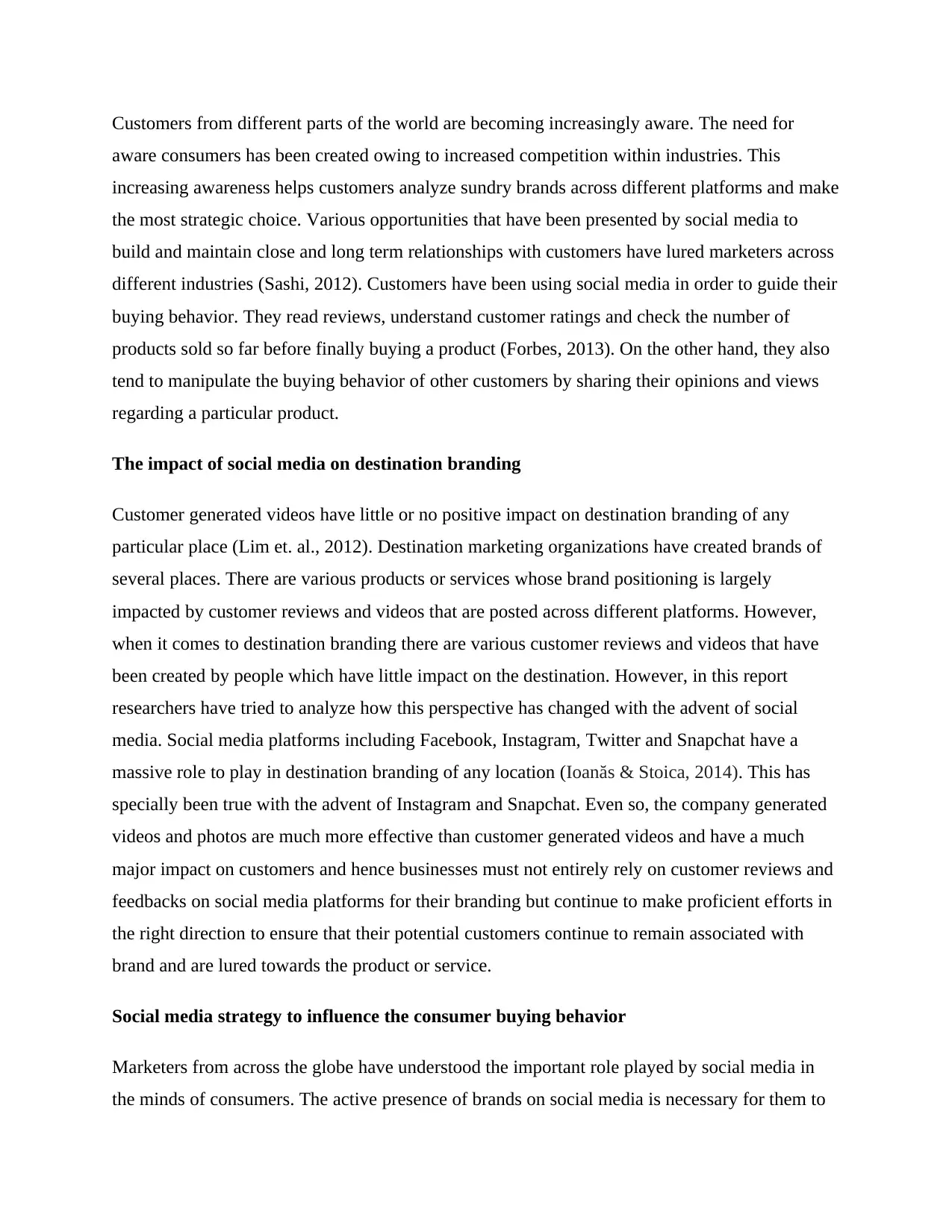
Customers from different parts of the world are becoming increasingly aware. The need for
aware consumers has been created owing to increased competition within industries. This
increasing awareness helps customers analyze sundry brands across different platforms and make
the most strategic choice. Various opportunities that have been presented by social media to
build and maintain close and long term relationships with customers have lured marketers across
different industries (Sashi, 2012). Customers have been using social media in order to guide their
buying behavior. They read reviews, understand customer ratings and check the number of
products sold so far before finally buying a product (Forbes, 2013). On the other hand, they also
tend to manipulate the buying behavior of other customers by sharing their opinions and views
regarding a particular product.
The impact of social media on destination branding
Customer generated videos have little or no positive impact on destination branding of any
particular place (Lim et. al., 2012). Destination marketing organizations have created brands of
several places. There are various products or services whose brand positioning is largely
impacted by customer reviews and videos that are posted across different platforms. However,
when it comes to destination branding there are various customer reviews and videos that have
been created by people which have little impact on the destination. However, in this report
researchers have tried to analyze how this perspective has changed with the advent of social
media. Social media platforms including Facebook, Instagram, Twitter and Snapchat have a
massive role to play in destination branding of any location (Ioanăs & Stoica, 2014). This has
specially been true with the advent of Instagram and Snapchat. Even so, the company generated
videos and photos are much more effective than customer generated videos and have a much
major impact on customers and hence businesses must not entirely rely on customer reviews and
feedbacks on social media platforms for their branding but continue to make proficient efforts in
the right direction to ensure that their potential customers continue to remain associated with
brand and are lured towards the product or service.
Social media strategy to influence the consumer buying behavior
Marketers from across the globe have understood the important role played by social media in
the minds of consumers. The active presence of brands on social media is necessary for them to
aware consumers has been created owing to increased competition within industries. This
increasing awareness helps customers analyze sundry brands across different platforms and make
the most strategic choice. Various opportunities that have been presented by social media to
build and maintain close and long term relationships with customers have lured marketers across
different industries (Sashi, 2012). Customers have been using social media in order to guide their
buying behavior. They read reviews, understand customer ratings and check the number of
products sold so far before finally buying a product (Forbes, 2013). On the other hand, they also
tend to manipulate the buying behavior of other customers by sharing their opinions and views
regarding a particular product.
The impact of social media on destination branding
Customer generated videos have little or no positive impact on destination branding of any
particular place (Lim et. al., 2012). Destination marketing organizations have created brands of
several places. There are various products or services whose brand positioning is largely
impacted by customer reviews and videos that are posted across different platforms. However,
when it comes to destination branding there are various customer reviews and videos that have
been created by people which have little impact on the destination. However, in this report
researchers have tried to analyze how this perspective has changed with the advent of social
media. Social media platforms including Facebook, Instagram, Twitter and Snapchat have a
massive role to play in destination branding of any location (Ioanăs & Stoica, 2014). This has
specially been true with the advent of Instagram and Snapchat. Even so, the company generated
videos and photos are much more effective than customer generated videos and have a much
major impact on customers and hence businesses must not entirely rely on customer reviews and
feedbacks on social media platforms for their branding but continue to make proficient efforts in
the right direction to ensure that their potential customers continue to remain associated with
brand and are lured towards the product or service.
Social media strategy to influence the consumer buying behavior
Marketers from across the globe have understood the important role played by social media in
the minds of consumers. The active presence of brands on social media is necessary for them to
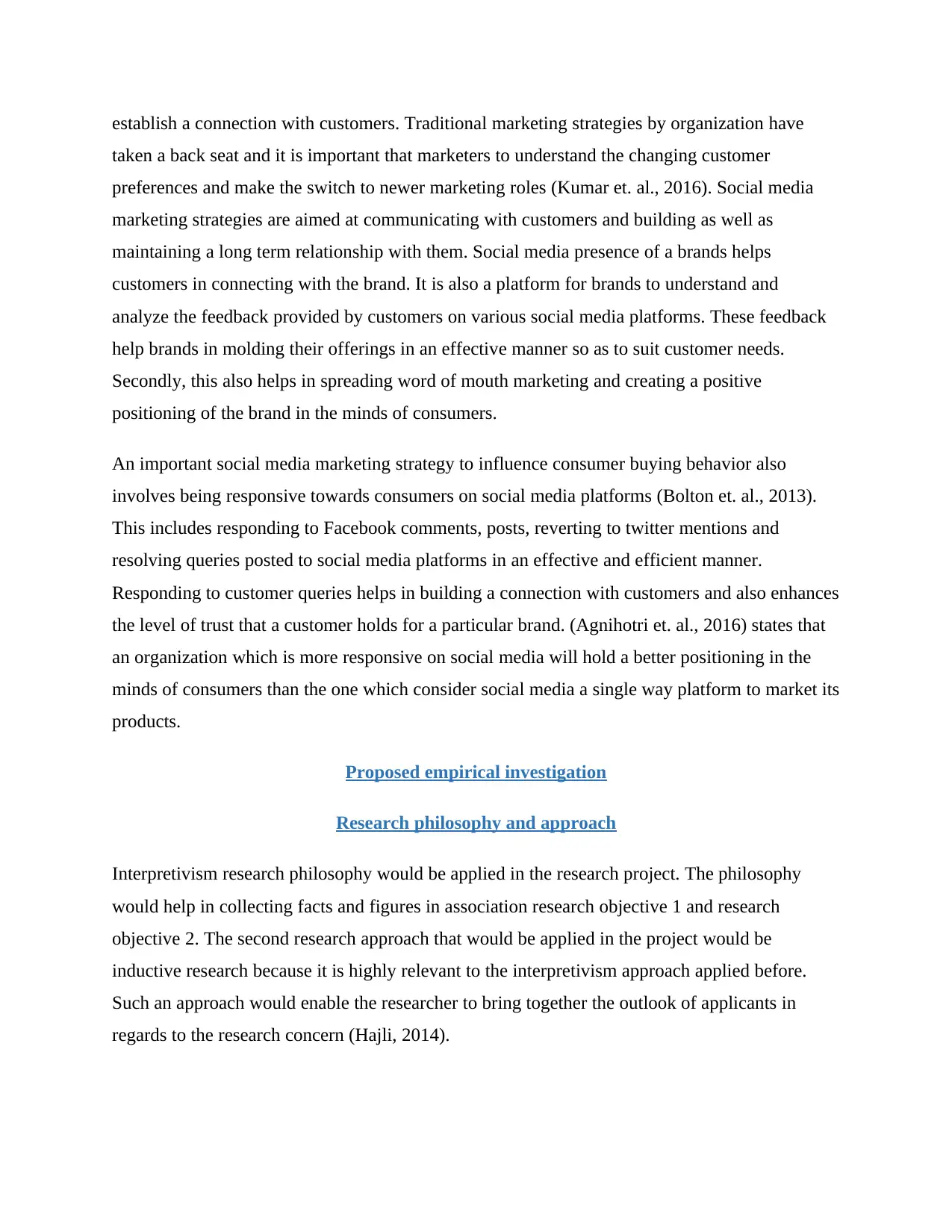
establish a connection with customers. Traditional marketing strategies by organization have
taken a back seat and it is important that marketers to understand the changing customer
preferences and make the switch to newer marketing roles (Kumar et. al., 2016). Social media
marketing strategies are aimed at communicating with customers and building as well as
maintaining a long term relationship with them. Social media presence of a brands helps
customers in connecting with the brand. It is also a platform for brands to understand and
analyze the feedback provided by customers on various social media platforms. These feedback
help brands in molding their offerings in an effective manner so as to suit customer needs.
Secondly, this also helps in spreading word of mouth marketing and creating a positive
positioning of the brand in the minds of consumers.
An important social media marketing strategy to influence consumer buying behavior also
involves being responsive towards consumers on social media platforms (Bolton et. al., 2013).
This includes responding to Facebook comments, posts, reverting to twitter mentions and
resolving queries posted to social media platforms in an effective and efficient manner.
Responding to customer queries helps in building a connection with customers and also enhances
the level of trust that a customer holds for a particular brand. (Agnihotri et. al., 2016) states that
an organization which is more responsive on social media will hold a better positioning in the
minds of consumers than the one which consider social media a single way platform to market its
products.
Proposed empirical investigation
Research philosophy and approach
Interpretivism research philosophy would be applied in the research project. The philosophy
would help in collecting facts and figures in association research objective 1 and research
objective 2. The second research approach that would be applied in the project would be
inductive research because it is highly relevant to the interpretivism approach applied before.
Such an approach would enable the researcher to bring together the outlook of applicants in
regards to the research concern (Hajli, 2014).
taken a back seat and it is important that marketers to understand the changing customer
preferences and make the switch to newer marketing roles (Kumar et. al., 2016). Social media
marketing strategies are aimed at communicating with customers and building as well as
maintaining a long term relationship with them. Social media presence of a brands helps
customers in connecting with the brand. It is also a platform for brands to understand and
analyze the feedback provided by customers on various social media platforms. These feedback
help brands in molding their offerings in an effective manner so as to suit customer needs.
Secondly, this also helps in spreading word of mouth marketing and creating a positive
positioning of the brand in the minds of consumers.
An important social media marketing strategy to influence consumer buying behavior also
involves being responsive towards consumers on social media platforms (Bolton et. al., 2013).
This includes responding to Facebook comments, posts, reverting to twitter mentions and
resolving queries posted to social media platforms in an effective and efficient manner.
Responding to customer queries helps in building a connection with customers and also enhances
the level of trust that a customer holds for a particular brand. (Agnihotri et. al., 2016) states that
an organization which is more responsive on social media will hold a better positioning in the
minds of consumers than the one which consider social media a single way platform to market its
products.
Proposed empirical investigation
Research philosophy and approach
Interpretivism research philosophy would be applied in the research project. The philosophy
would help in collecting facts and figures in association research objective 1 and research
objective 2. The second research approach that would be applied in the project would be
inductive research because it is highly relevant to the interpretivism approach applied before.
Such an approach would enable the researcher to bring together the outlook of applicants in
regards to the research concern (Hajli, 2014).
⊘ This is a preview!⊘
Do you want full access?
Subscribe today to unlock all pages.

Trusted by 1+ million students worldwide
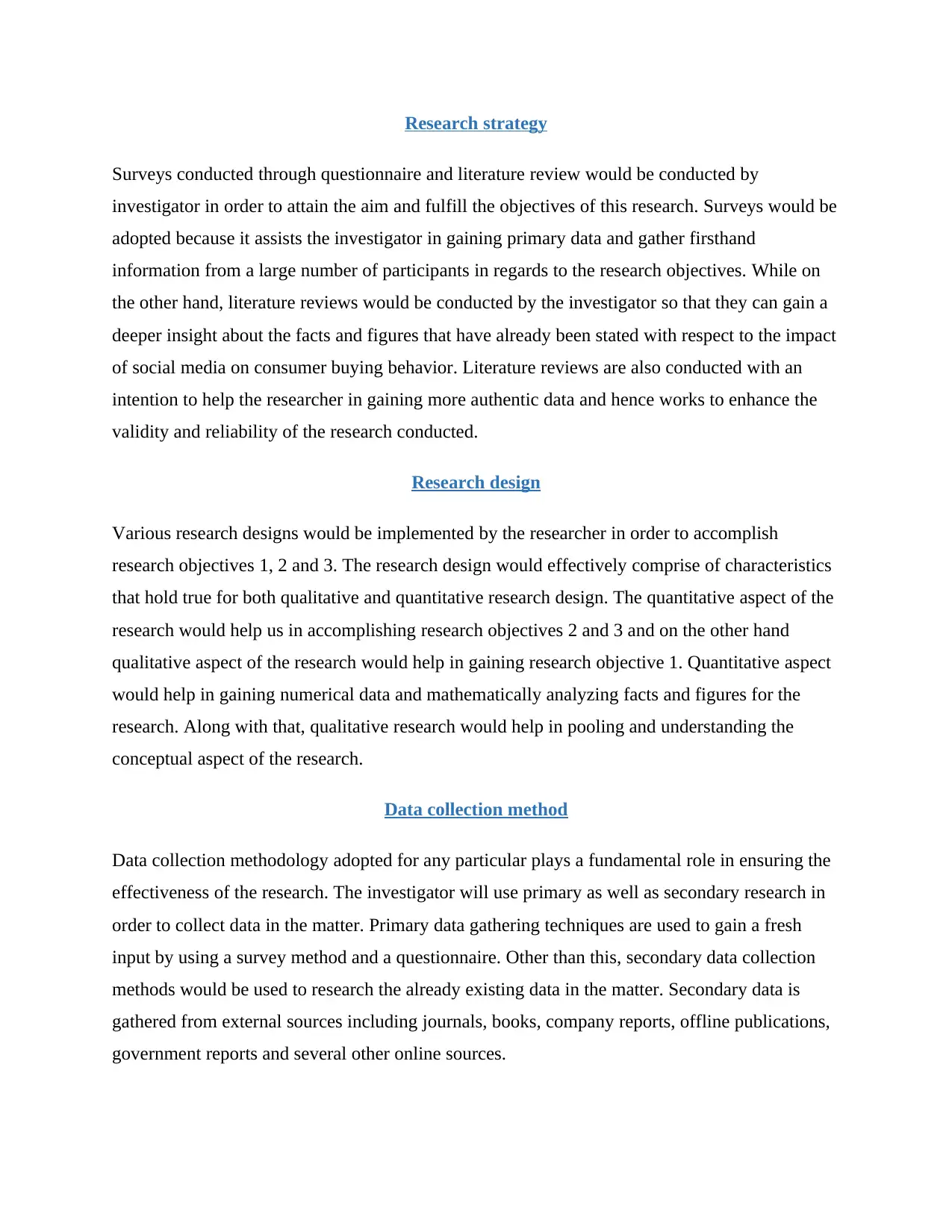
Research strategy
Surveys conducted through questionnaire and literature review would be conducted by
investigator in order to attain the aim and fulfill the objectives of this research. Surveys would be
adopted because it assists the investigator in gaining primary data and gather firsthand
information from a large number of participants in regards to the research objectives. While on
the other hand, literature reviews would be conducted by the investigator so that they can gain a
deeper insight about the facts and figures that have already been stated with respect to the impact
of social media on consumer buying behavior. Literature reviews are also conducted with an
intention to help the researcher in gaining more authentic data and hence works to enhance the
validity and reliability of the research conducted.
Research design
Various research designs would be implemented by the researcher in order to accomplish
research objectives 1, 2 and 3. The research design would effectively comprise of characteristics
that hold true for both qualitative and quantitative research design. The quantitative aspect of the
research would help us in accomplishing research objectives 2 and 3 and on the other hand
qualitative aspect of the research would help in gaining research objective 1. Quantitative aspect
would help in gaining numerical data and mathematically analyzing facts and figures for the
research. Along with that, qualitative research would help in pooling and understanding the
conceptual aspect of the research.
Data collection method
Data collection methodology adopted for any particular plays a fundamental role in ensuring the
effectiveness of the research. The investigator will use primary as well as secondary research in
order to collect data in the matter. Primary data gathering techniques are used to gain a fresh
input by using a survey method and a questionnaire. Other than this, secondary data collection
methods would be used to research the already existing data in the matter. Secondary data is
gathered from external sources including journals, books, company reports, offline publications,
government reports and several other online sources.
Surveys conducted through questionnaire and literature review would be conducted by
investigator in order to attain the aim and fulfill the objectives of this research. Surveys would be
adopted because it assists the investigator in gaining primary data and gather firsthand
information from a large number of participants in regards to the research objectives. While on
the other hand, literature reviews would be conducted by the investigator so that they can gain a
deeper insight about the facts and figures that have already been stated with respect to the impact
of social media on consumer buying behavior. Literature reviews are also conducted with an
intention to help the researcher in gaining more authentic data and hence works to enhance the
validity and reliability of the research conducted.
Research design
Various research designs would be implemented by the researcher in order to accomplish
research objectives 1, 2 and 3. The research design would effectively comprise of characteristics
that hold true for both qualitative and quantitative research design. The quantitative aspect of the
research would help us in accomplishing research objectives 2 and 3 and on the other hand
qualitative aspect of the research would help in gaining research objective 1. Quantitative aspect
would help in gaining numerical data and mathematically analyzing facts and figures for the
research. Along with that, qualitative research would help in pooling and understanding the
conceptual aspect of the research.
Data collection method
Data collection methodology adopted for any particular plays a fundamental role in ensuring the
effectiveness of the research. The investigator will use primary as well as secondary research in
order to collect data in the matter. Primary data gathering techniques are used to gain a fresh
input by using a survey method and a questionnaire. Other than this, secondary data collection
methods would be used to research the already existing data in the matter. Secondary data is
gathered from external sources including journals, books, company reports, offline publications,
government reports and several other online sources.
Paraphrase This Document
Need a fresh take? Get an instant paraphrase of this document with our AI Paraphraser
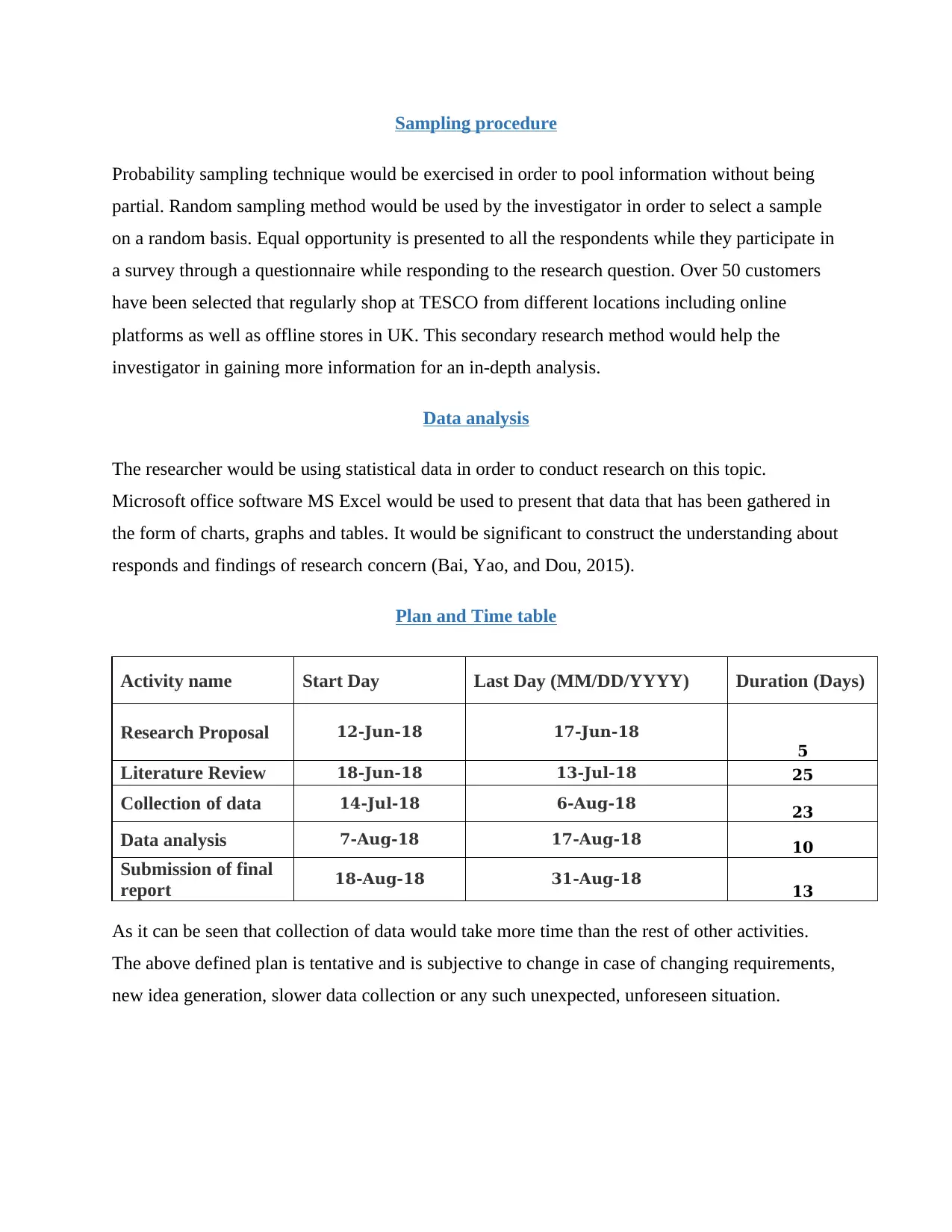
Sampling procedure
Probability sampling technique would be exercised in order to pool information without being
partial. Random sampling method would be used by the investigator in order to select a sample
on a random basis. Equal opportunity is presented to all the respondents while they participate in
a survey through a questionnaire while responding to the research question. Over 50 customers
have been selected that regularly shop at TESCO from different locations including online
platforms as well as offline stores in UK. This secondary research method would help the
investigator in gaining more information for an in-depth analysis.
Data analysis
The researcher would be using statistical data in order to conduct research on this topic.
Microsoft office software MS Excel would be used to present that data that has been gathered in
the form of charts, graphs and tables. It would be significant to construct the understanding about
responds and findings of research concern (Bai, Yao, and Dou, 2015).
Plan and Time table
Activity name Start Day Last Day (MM/DD/YYYY) Duration (Days)
Research Proposal 12-Jun-18 17-Jun-18
5
Literature Review 18-Jun-18 13-Jul-18 25
Collection of data 14-Jul-18 6-Aug-18 23
Data analysis 7-Aug-18 17-Aug-18 10
Submission of final
report 18-Aug-18 31-Aug-18 13
As it can be seen that collection of data would take more time than the rest of other activities.
The above defined plan is tentative and is subjective to change in case of changing requirements,
new idea generation, slower data collection or any such unexpected, unforeseen situation.
Probability sampling technique would be exercised in order to pool information without being
partial. Random sampling method would be used by the investigator in order to select a sample
on a random basis. Equal opportunity is presented to all the respondents while they participate in
a survey through a questionnaire while responding to the research question. Over 50 customers
have been selected that regularly shop at TESCO from different locations including online
platforms as well as offline stores in UK. This secondary research method would help the
investigator in gaining more information for an in-depth analysis.
Data analysis
The researcher would be using statistical data in order to conduct research on this topic.
Microsoft office software MS Excel would be used to present that data that has been gathered in
the form of charts, graphs and tables. It would be significant to construct the understanding about
responds and findings of research concern (Bai, Yao, and Dou, 2015).
Plan and Time table
Activity name Start Day Last Day (MM/DD/YYYY) Duration (Days)
Research Proposal 12-Jun-18 17-Jun-18
5
Literature Review 18-Jun-18 13-Jul-18 25
Collection of data 14-Jul-18 6-Aug-18 23
Data analysis 7-Aug-18 17-Aug-18 10
Submission of final
report 18-Aug-18 31-Aug-18 13
As it can be seen that collection of data would take more time than the rest of other activities.
The above defined plan is tentative and is subjective to change in case of changing requirements,
new idea generation, slower data collection or any such unexpected, unforeseen situation.
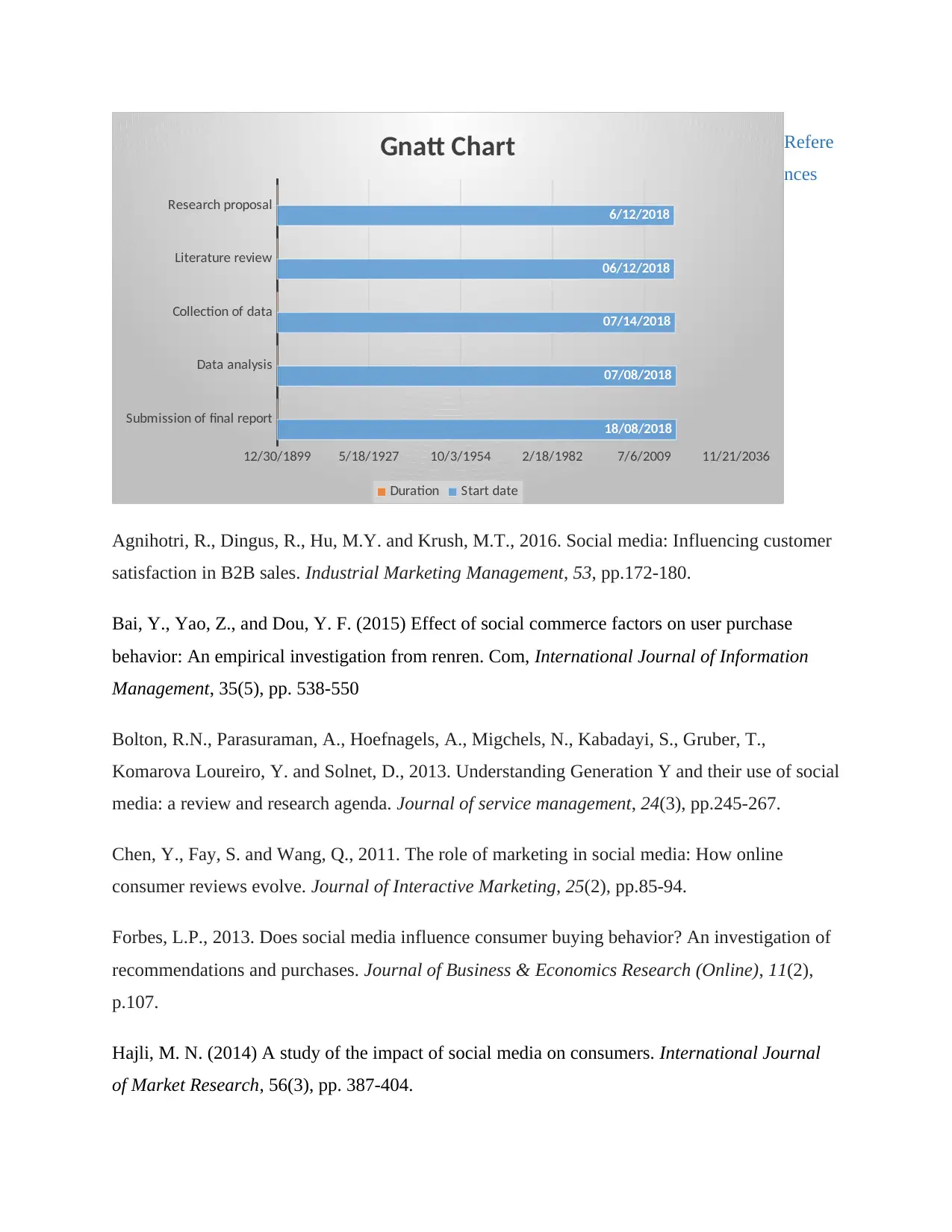
Refere
nces
Agnihotri, R., Dingus, R., Hu, M.Y. and Krush, M.T., 2016. Social media: Influencing customer
satisfaction in B2B sales. Industrial Marketing Management, 53, pp.172-180.
Bai, Y., Yao, Z., and Dou, Y. F. (2015) Effect of social commerce factors on user purchase
behavior: An empirical investigation from renren. Com, International Journal of Information
Management, 35(5), pp. 538-550
Bolton, R.N., Parasuraman, A., Hoefnagels, A., Migchels, N., Kabadayi, S., Gruber, T.,
Komarova Loureiro, Y. and Solnet, D., 2013. Understanding Generation Y and their use of social
media: a review and research agenda. Journal of service management, 24(3), pp.245-267.
Chen, Y., Fay, S. and Wang, Q., 2011. The role of marketing in social media: How online
consumer reviews evolve. Journal of Interactive Marketing, 25(2), pp.85-94.
Forbes, L.P., 2013. Does social media influence consumer buying behavior? An investigation of
recommendations and purchases. Journal of Business & Economics Research (Online), 11(2),
p.107.
Hajli, M. N. (2014) A study of the impact of social media on consumers. International Journal
of Market Research, 56(3), pp. 387-404.
Submission of final report
Data analysis
Collection of data
Literature review
Research proposal
12/30/1899 5/18/1927 10/3/1954 2/18/1982 7/6/2009 11/21/2036
18/08/2018
07/08/2018
07/14/2018
06/12/2018
6/12/2018
Gnatt Chart
Duration Start date
nces
Agnihotri, R., Dingus, R., Hu, M.Y. and Krush, M.T., 2016. Social media: Influencing customer
satisfaction in B2B sales. Industrial Marketing Management, 53, pp.172-180.
Bai, Y., Yao, Z., and Dou, Y. F. (2015) Effect of social commerce factors on user purchase
behavior: An empirical investigation from renren. Com, International Journal of Information
Management, 35(5), pp. 538-550
Bolton, R.N., Parasuraman, A., Hoefnagels, A., Migchels, N., Kabadayi, S., Gruber, T.,
Komarova Loureiro, Y. and Solnet, D., 2013. Understanding Generation Y and their use of social
media: a review and research agenda. Journal of service management, 24(3), pp.245-267.
Chen, Y., Fay, S. and Wang, Q., 2011. The role of marketing in social media: How online
consumer reviews evolve. Journal of Interactive Marketing, 25(2), pp.85-94.
Forbes, L.P., 2013. Does social media influence consumer buying behavior? An investigation of
recommendations and purchases. Journal of Business & Economics Research (Online), 11(2),
p.107.
Hajli, M. N. (2014) A study of the impact of social media on consumers. International Journal
of Market Research, 56(3), pp. 387-404.
Submission of final report
Data analysis
Collection of data
Literature review
Research proposal
12/30/1899 5/18/1927 10/3/1954 2/18/1982 7/6/2009 11/21/2036
18/08/2018
07/08/2018
07/14/2018
06/12/2018
6/12/2018
Gnatt Chart
Duration Start date
⊘ This is a preview!⊘
Do you want full access?
Subscribe today to unlock all pages.

Trusted by 1+ million students worldwide
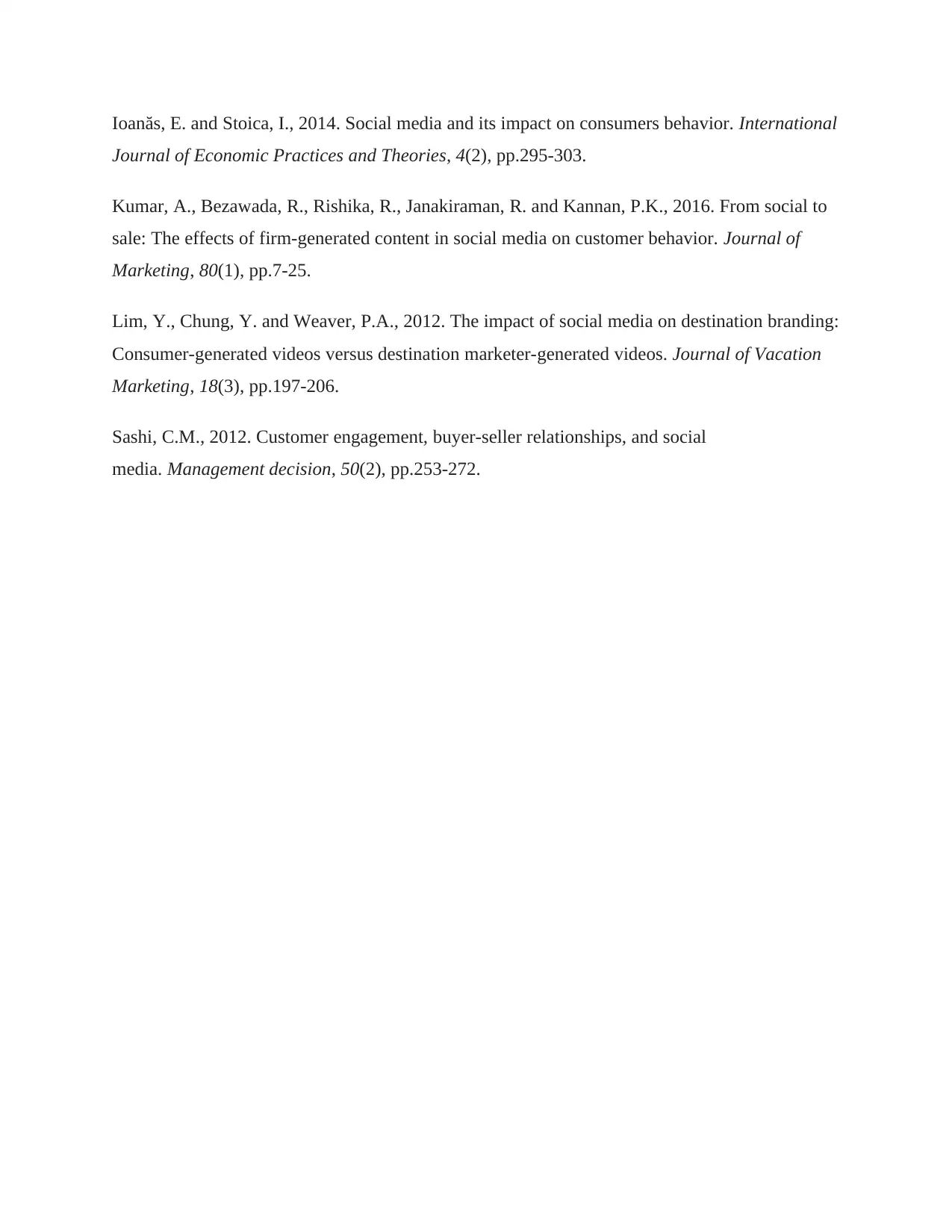
Ioanăs, E. and Stoica, I., 2014. Social media and its impact on consumers behavior. International
Journal of Economic Practices and Theories, 4(2), pp.295-303.
Kumar, A., Bezawada, R., Rishika, R., Janakiraman, R. and Kannan, P.K., 2016. From social to
sale: The effects of firm-generated content in social media on customer behavior. Journal of
Marketing, 80(1), pp.7-25.
Lim, Y., Chung, Y. and Weaver, P.A., 2012. The impact of social media on destination branding:
Consumer-generated videos versus destination marketer-generated videos. Journal of Vacation
Marketing, 18(3), pp.197-206.
Sashi, C.M., 2012. Customer engagement, buyer-seller relationships, and social
media. Management decision, 50(2), pp.253-272.
Journal of Economic Practices and Theories, 4(2), pp.295-303.
Kumar, A., Bezawada, R., Rishika, R., Janakiraman, R. and Kannan, P.K., 2016. From social to
sale: The effects of firm-generated content in social media on customer behavior. Journal of
Marketing, 80(1), pp.7-25.
Lim, Y., Chung, Y. and Weaver, P.A., 2012. The impact of social media on destination branding:
Consumer-generated videos versus destination marketer-generated videos. Journal of Vacation
Marketing, 18(3), pp.197-206.
Sashi, C.M., 2012. Customer engagement, buyer-seller relationships, and social
media. Management decision, 50(2), pp.253-272.
1 out of 10
Related Documents
Your All-in-One AI-Powered Toolkit for Academic Success.
+13062052269
info@desklib.com
Available 24*7 on WhatsApp / Email
![[object Object]](/_next/static/media/star-bottom.7253800d.svg)
Unlock your academic potential
Copyright © 2020–2025 A2Z Services. All Rights Reserved. Developed and managed by ZUCOL.




